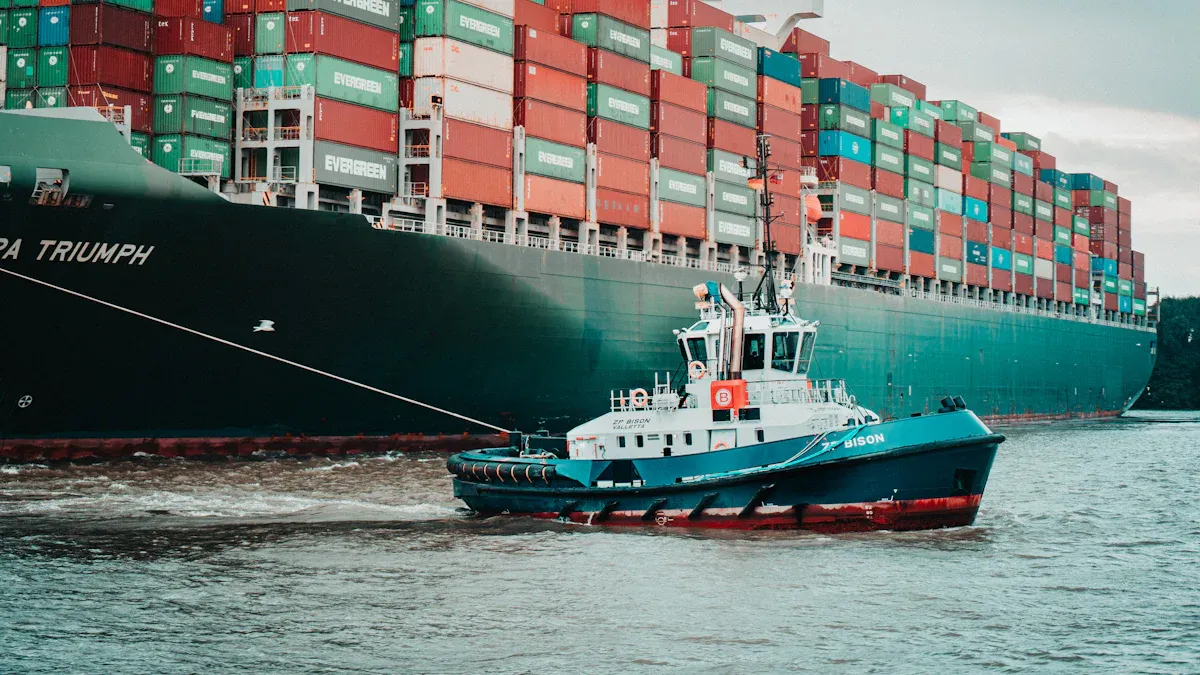Future Blueprint and Breakthrough Strategies for Supply Chain Resilience Transformation

Global disruptions, from pandemics to natural disasters, have highlighted the importance of supply chain resilience. Businesses must adapt to unpredictable challenges to maintain operational continuity. Innovative strategies play a vital role in this transformation. Predictive modeling and risk assessment help forecast disruptions and mitigate risks effectively. Real-time monitoring systems provide immediate insights, enabling swift responses to emerging issues. Data integration from multiple sources enhances decision-making, while survival analysis ensures proactive maintenance. These advancements empower organizations to build robust supply chains capable of withstanding future uncertainties.
Key Takeaways
Strong supply chains help businesses handle problems like pandemics or disasters.
Using many suppliers lowers risks and keeps work running in crises.
Tools like AI and IoT make supply chains faster and smarter.
Working together in the supply chain builds trust and solves problems quickly.
Being eco-friendly helps the planet, saves money, and boosts brand image.
Challenges Impacting Supply Chain Resilience
Global Disruptions and Their Ripple Effects
Global disruptions have exposed vulnerabilities in supply chains worldwide. Events such as pandemics, natural disasters, and economic crises create cascading effects that disrupt operations. For instance:
Supplier disruptions, such as bankruptcies or production delays, can cause bottlenecks across the network.
Transportation failures, including port congestion or strikes, delay goods delivery.
These disruptions highlight the interconnected nature of supply chains. A single weak link can impact downstream operations, leading to inefficiencies and financial losses. Collaborative strategies, such as vertical and horizontal partnerships, can mitigate these risks.
Collaborative Strategy Type | Description |
|---|---|
Vertical Collaborative Strategies | Involves inter-firm collaboration to enhance responsiveness to disruptions like the Covid-19 pandemic. |
Horizontal Collaborative Strategies | Involves intra-firm collaboration to improve operational flexibility during disruptions. |
Geopolitical Tensions and Trade Uncertainties
Geopolitical tensions significantly influence trade and supply chain resilience. Tariff wars, sanctions, and political instability disrupt trade flows and increase market volatility. For example, in 2023, Mexico became the leading U.S. import partner for manufactured goods, surpassing China. This shift reflects how geopolitical factors reshape global trade dynamics.
Indicator | Description |
|---|---|
Geopolitical Risk Index (GPR) | Measures geopolitical risk by analyzing the frequency of specific terms related to geopolitical tensions in major newspapers. |
Political Risk Indexes (PRI) | Assesses political stability, conflict likelihood, and government effectiveness. |
Economic Impact Modeling | Uses historical data to estimate the effects of geopolitical events on GDP, inflation, and trade balances. |
Among the top 15 manufactured goods imported by the U.S., six are critical intermediate inputs, including motor vehicle parts and electrical components. Disruptions in these areas can severely impact production and supply chain efficiency.
Addressing Environmental and Sustainability Pressures
Environmental challenges, such as climate change, add another layer of complexity to supply chain resilience. Extreme weather events, including floods and wildfires, disrupt operations and transportation networks. Effective environmental management minimizes resource waste and harmful emissions while improving worker health. Companies can optimize production processes to increase resource efficiency and reduce costs.
A sustainable supply chain strategy relies on tracking social and environmental performance indicators, such as energy usage and modern slavery risks. Monitoring Scope 3 emissions from suppliers helps identify reduction opportunities and demonstrates progress toward sustainability goals. By adopting these practices, businesses can enhance resilience and align with global sustainability standards.
Breakthrough Strategies for Supply Chain Resilience

Multi-Sourcing and Supplier Diversification
Multi-sourcing and supplier diversification strengthen supply chain resilience by reducing dependency on a single supplier or region. Companies that rely on one supplier face heightened risks during disruptions, such as natural disasters or geopolitical tensions. Diversifying suppliers ensures continuity in operations and minimizes the impact of localized issues.
For example, businesses that adopt multi-sourcing strategies recover faster from disruptions. Comparative data shows that resilient supply chains maintain approximately 15% higher service levels during crisis periods. This approach also enables companies to negotiate better terms, improve cost efficiency, and access a broader range of resources.
To implement supplier diversification effectively, organizations should:
Identify critical components and materials that require multiple sourcing options.
Evaluate suppliers based on reliability, capacity, and geographic location.
Establish contingency plans to address potential risks in supplier networks.
By diversifying their supplier base, businesses can build robust supply chains capable of adapting to unforeseen challenges.
Strategic Inventory Planning and Demand Forecasting
Strategic inventory planning and demand forecasting are essential for maintaining optimal stock levels and ensuring supply chain efficiency. Accurate forecasting helps businesses anticipate customer demand and avoid overstocking or stockouts. Forecast Accuracy (FA) and demand-planning KPIs guide organizations in achieving these goals.
Key metrics and techniques include:
Forecast Accuracy (FA): Assesses the reliability of demand forecasts, ensuring alignment with market needs.
Reorder Point Formulas: Determine when to replenish inventory based on demand peaks.
Statistical Forecasting: Predicts customer demand using historical data and trends.
Demand planners collaborate with product managers and sales teams to align inventory with market conditions. Inventory planners focus on minimizing handling costs while maintaining sufficient stock to meet customer orders. This approach ensures efficient supply chain operations and reduces risks associated with fluctuating demand.
Companies that excel in inventory forecasting recover faster from disruptions and maintain higher service levels during crises. By analyzing past data and adapting to changing conditions, businesses can enhance supply chain resilience and optimize inventory management.
Building Collaborative Partnerships Across the Supply Chain
Collaborative partnerships across the supply chain foster resilience by promoting transparency, trust, and shared goals among stakeholders. These partnerships enable businesses to respond effectively to disruptions and improve overall efficiency.
Collaboration can take various forms:
Vertical Collaboration: Involves partnerships between suppliers and manufacturers to enhance responsiveness during disruptions.
Horizontal Collaboration: Focuses on cooperation within organizations to improve operational flexibility.
For instance, during the COVID-19 pandemic, vertical collaboration helped companies adapt to supply chain challenges by aligning production schedules with supplier capabilities. Horizontal collaboration ensured seamless communication between departments, reducing delays and inefficiencies.
To build strong partnerships, organizations should:
Establish clear communication channels for real-time information sharing.
Develop joint risk management strategies to address potential disruptions.
Invest in technology platforms that facilitate collaboration and data integration.
Collaborative partnerships create a resilient supply chain ecosystem that can withstand global challenges and drive long-term success.
Future Blueprint for Supply Chain Transformation

Leveraging Technology for Resilience (AI, IoT, Blockchain)
Technology plays a pivotal role in enhancing supply chain resilience. Advanced tools like artificial intelligence (AI), the Internet of Things (IoT), and blockchain are transforming traditional supply chain operations into highly efficient and transparent systems. These technologies enable businesses to predict disruptions, optimize processes, and improve decision-making.
AI and machine learning algorithms analyze vast amounts of data to optimize routing, scheduling, and resource allocation. This reduces operational costs and enhances efficiency. IoT devices, such as sensors and RFID tags, provide real-time tracking and monitoring of goods. This visibility allows businesses to make proactive decisions and respond swiftly to potential disruptions. Blockchain technology ensures secure and transparent record-keeping, improving traceability and authenticity. This is particularly valuable in industries like food and pharmaceuticals, where product integrity is critical.
Digital transformation studies highlight the benefits of integrating these technologies. For instance:
Digital tools simplify and automate supply chain functions, enhancing visibility and decision-making.
McKinsey reports that digital transformation reduces lead times and improves demand forecasting.
These advancements empower organizations to build robust supply chains capable of withstanding future uncertainties.
Digital Twins and Predictive Modeling in Supply Chains
Digital twins and predictive modeling are revolutionizing supply chain management. A digital twin is a virtual replica of a physical system, enabling businesses to simulate scenarios and optimize operations. Predictive modeling uses historical data and algorithms to forecast future events, helping organizations prepare for potential disruptions.
Agility and Adaptability as Key Drivers of Future Supply Chains
Agility and adaptability are essential for future supply chains. Agility refers to the ability to respond quickly to changes, while adaptability focuses on long-term adjustments to evolving conditions. Together, they enable businesses to navigate disruptions and maintain operational continuity.
Key performance metrics validate the importance of agility and adaptability:
Performance Metric | Description |
|---|---|
Demand sensing | The ability to anticipate customer demand and adjust supply accordingly. |
Collaborative relationships | Building partnerships that enhance communication and resource sharing. |
Process integration | Streamlining operations across different functions for better efficiency. |
Information integration | Ensuring data flows seamlessly across the supply chain for informed decision-making. |
Dynamic inventory management supported by real-time data exemplifies agility. This approach reduces the lag between demand and supply, preventing significant stockouts during disruptions. Hyperautomation, which combines robotics and AI, minimizes human error and streamlines logistics processes. Resilient supply chain networks, featuring regional hubs and localized production, reduce dependency on long, globalized chains.
By prioritizing agility and adaptability, businesses can create supply chains that are not only resilient but also capable of thriving in an ever-changing global landscape.
Sustainability as a Pillar of Supply Chain Resilience
Sustainability has become a cornerstone of modern supply chain strategies. Companies increasingly recognize that resilient supply chains must align with environmental, social, and governance (ESG) principles. This alignment not only addresses global environmental challenges but also enhances operational efficiency and brand reputation.
Sustainable supply chains prioritize reducing carbon footprints, minimizing waste, and optimizing resource utilization. For example, businesses adopting circular economy models extend the lifecycle of materials through recycling and reuse. This approach reduces dependency on raw materials and mitigates supply risks. Additionally, renewable energy integration in production and logistics operations significantly lowers greenhouse gas emissions.
Tracking and managing Scope 3 emissions, which include indirect emissions from suppliers, is critical. Companies that monitor these emissions gain insights into their environmental impact and identify areas for improvement. Advanced technologies, such as blockchain, enhance transparency by providing immutable records of sustainability metrics across the supply chain.
Sustainability also involves addressing social factors. Ethical labor practices and fair wages improve workforce morale and productivity. Companies that ensure compliance with labor standards reduce risks associated with reputational damage and legal penalties. Furthermore, sustainable practices attract environmentally conscious consumers, creating a competitive advantage in the market.
By embedding sustainability into supply chain resilience strategies, businesses not only contribute to global environmental goals but also build robust systems capable of withstanding future disruptions.
Workforce Development and Upskilling for the Future
The future of supply chains depends on a skilled and adaptable workforce. Rapid technological advancements, such as automation and artificial intelligence, are transforming supply chain operations. To keep pace, companies must invest in workforce development and upskilling programs.
Upskilling initiatives equip employees with the knowledge and skills required to operate advanced technologies. For instance, training programs in data analytics and machine learning enable workers to analyze supply chain data effectively. Similarly, certifications in logistics management enhance employees' ability to optimize transportation and inventory processes.
The impact of workforce development programs is evident in their outcomes. For example, the STEM Starter Academy (SSA) trained 31,000 participants in 2020, with 64% reporting positive outcomes. These programs not only improve individual career prospects but also strengthen organizational capabilities.
Workforce development also fosters innovation. Employees trained in emerging technologies contribute to process improvements and problem-solving. Moreover, a skilled workforce enhances supply chain resilience by ensuring continuity during disruptions. Workers with cross-functional skills can adapt to changing roles and responsibilities, minimizing operational downtime.
Organizations that prioritize upskilling create a culture of continuous learning. This culture attracts top talent and reduces employee turnover. Additionally, partnerships with educational institutions and industry experts provide access to cutting-edge training resources.
JUSDA’s Role in Transforming Supply Chain Resilience
How JUSDA’s Global Network Enhances Resilience
JUSDA’s extensive global network plays a pivotal role in strengthening supply chain resilience. With over 155 service points worldwide and a warehouse area exceeding 2,500,000 square meters, JUSDA ensures seamless logistics operations across diverse industries. Its robust infrastructure supports various transportation modes, including air, land, sea, and rail, enabling businesses to adapt to disruptions effectively.
The company’s global reach allows it to mitigate risks associated with regional disruptions. For instance, its multi-modal transportation capabilities ensure continuity even when one mode faces challenges. Additionally, JUSDA’s expertise in customs clearance and trade compliance simplifies cross-border operations, reducing delays and enhancing efficiency.
By leveraging its global network, JUSDA empowers businesses to maintain operational continuity and adapt to evolving market conditions. This comprehensive approach ensures that companies can navigate uncertainties with confidence.
JusLink’s Intelligent Supply Chain Capabilities
JusLink, JUSDA’s intelligent supply chain platform, revolutionizes supply chain management through advanced technology. It integrates AI, IoT, and big data to provide real-time visibility and predictive insights. These capabilities enable businesses to anticipate disruptions and respond proactively.
Key features of JusLink include AI-driven sales forecasting, intelligent replenishment management, and automated application management. The platform’s Control Tower Intelligent Risk Management system monitors supply chain risks in real time, offering timely alerts and actionable insights. Its microservices architecture allows customization, ensuring solutions tailored to specific business needs.
JusLink enhances supply chain efficiency by optimizing inventory levels, reducing risks, and improving decision-making. Businesses using JusLink gain a competitive edge by streamlining operations and achieving greater resilience.

JUSDA Solutions
To provide you with professional solutions and quotations.
Case Study: JUSDA’s Impact on Global Manufacturers
JUSDA’s solutions have significantly impacted global manufacturers, as demonstrated by its collaboration with Sharp. Sharp faced challenges in managing its global e-commerce logistics. By implementing JUSDA’s Supply Chain Management Collaboration Platform, Sharp optimized its logistics operations, reducing costs by 20% and improving order processing cycles.
The platform’s demand forecasting and inventory management capabilities enabled Sharp to align production with market demand. Additionally, its transport coordination features ensured timely deliveries, enhancing customer satisfaction. This case study highlights JUSDA’s ability to address complex supply chain challenges and deliver measurable results.
Through innovative solutions and strategic partnerships, JUSDA continues to transform supply chain resilience for manufacturers worldwide.
The necessity of supply chain resilience continues to grow in today’s unpredictable world. Businesses must adopt strategies that enhance efficiency, reduce risks, and improve responsiveness. Resilience metrics provide a clear framework for monitoring supply chain health and driving data-driven decisions. A holistic approach, combining proactive risk management and agile processes, ensures long-term stability. Strategic investments in digital transformation and innovations like AI and predictive analytics further strengthen supply chain responsiveness.
JUSDA and its JusLink platform exemplify the power of digital transformation. Companies leveraging these solutions have reduced lead times by 20% and improved their ability to adapt to market changes. These advancements not only enhance customer satisfaction but also position businesses as leaders in supply chain innovation.
FAQ
What industries benefit most from JUSDA’s services?
JUSDA serves industries like electronics, automotive, FMCG, and medical health. Its tailored solutions address unique challenges, such as complex logistics, inventory management, and cross-border trade, ensuring efficiency and resilience for diverse sectors.
How does JusLink improve supply chain efficiency?
JusLink uses AI-driven forecasting, intelligent replenishment, and real-time risk monitoring. These features optimize inventory levels, reduce disruptions, and enhance decision-making. Its microservices architecture allows businesses to customize solutions for specific needs.
Why is sustainability crucial for supply chain resilience?
Sustainability reduces environmental impact and enhances operational efficiency. Practices like tracking Scope 3 emissions, adopting renewable energy, and ethical labor standards align supply chains with global goals. Sustainable strategies also attract eco-conscious consumers and improve brand reputation.
See Also
Jusda: Achieving Success Through Supply Chain Resilience
Career Advancement Opportunities in Tomorrow's Supply Chain
Embracing Change: Adapting to Technology in Supply Chains
Transforming Industries with Cloud-Based Supply Chain Solutions
Innovative Supply Chain Solutions Revolutionizing Logistics Today
